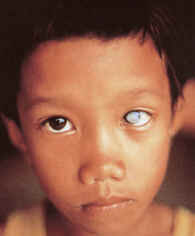Golden Rice fills a gap
Biofortified crops: Solving a huge problem without interfering with tradition
According to UNICEF, the estimated number of children deaths precipitated worldwide by vitamin A deficiency (VAD) every year lies at 1.15 million. Many more show VAD-related syndromes, among them loss of sight and increased susceptibility to a number of diseases. Biofortification –the creation of plants that make or accumulate micronutrients– has the potential to reduce these numbers significantly. The aim of biofortification is to improve the primary food source of hundreds of millions of people by increasing the nutritional quality of staple crops.
Golden Rice is a good example of a biofortified crop. In this specific case biofortification was obtained by genetic modification of the rice plant to produce and accumulate provitamin A (β-carotene) in the grain, something that doesn't happen in naturally occurring rice plants. This feat was accomplished by Ingo Potrykus, professor emeritus of the Federal Institute of Technology, Switzerland, and Professor Peter Beyer of the University of Freiburg, Germany, in the late 1990s, after several years of work, and has been further improved since then.
In developing countries 500,000 people, mainly children, become blind every year, 50 percent of which die within a year of becoming blind. Nearly nine million children die of malnutrion every year. VAD severely affects the immune system, hence it is involved in many of these children's deaths in the guise of a number of diseases. Recently, malaria deaths in children under five years of age has been linked to deficiencies in the intake of protein, vitamin A and zinc (Caulfield et al., 2004).
Various public and international programs are involved in supplementation (eg administering pills and capsules to small children), industrial fortification (eg adding vitamin A to butter or oil) and promoting diet diversification. These efforts have achieved substantial improvements but have difficulty in attaining full coverage and above all, sustainability. Biofortification through conventional breeding of genetically improved basic staple crops, offers a great opportunity to obtain a more inclusive coverage, especially among the poorest sectors of society.

Fig 1. Blindness is only the tip of the iceberg. Blindness is an easily recognisable symptom of VAD, but it is only the most visible of a complex set of life-threatening illnesses, including reduced immune competence, resulting in increased morbidity and mortality (largely from increased severity of infectious diseases); night blindness, corneal ulcers, keratomalacia and related ocular signs and symptoms of xerophthalmia; exacerbation of anemia through suboptimal absorption and utilization of iron; and other conditions not yet fully identified or clarified (eg retardation of growth and development).

Fig 2. Cause-specific mortality and malnutrition. All causes of death are to some degree associated with malnutrition (total 54 percent). Zinc supplementation has a direct effect on preventing deaths from diarrhoeal disease, for example, while vitamin A helps prevent death from measles, malaria, respiratory and other infections ARI, acute respiratory infections. (Pelletier et al 1993).
In the developing world mortality caused by all major diseases is associated with malnutrition. In fact, 54 percent of all infants' deaths are related to deficient nutrition levels, and above all to a lack of essential micronutrients. Sufficient caloric intake can often be misleading when evaluating the nutritional status of children. The most important staple crops in the world are rich in starch but poor in vital micronutrients. This does not affect affluent people who can afford to buy a varied diet that includes vegetables and fruits.
"Half of the global population consists of people who are living on less than $2 per day. Thus there is an urgent need to achieve higher levels of productivity in agriculture, to help alleviate these problems.
Any effort to deny access to technologies that are demonstrably helpful in feeding the people of the world must for this reason be judged from a moral and ethical point of view in relation to its real, and not its imagined, effect on human welfare."
-- Dr Peter H. Raven, Pontifical Academician; Director of the Missouri Botanical Garden.
Cited bibliography
- Caulfield LE, Richard SA, Black R (2004) Undernutrition as an underlying cause of malaria morbidity and mortality in children less than five years old. Am J Trop Med Hyg 71 (Suppl 2) 55-63.
- Pelletier DL, Frongillo EA Jr, Schroeder DG, Habicht J-P (1993) Epidemiological evidence for a potentiating effect of malnutrition on child mortality. American Journal of Public Health, 83:1130-1133.
- Sommer A. Vitamin A Deficiency Disorders: Origins of the Problem and Approaches to Its Control. AgBioWorld. www.agbioworld.org.
- Sommer A, Hussaini G, Tarwotjo I, Susanto D (1983) Increased mortality in children with mild vitamin A deficiency. Lancet 2:585-588.
- Stein AJ, Meenakshi JV, Qaim M, Nestel P, Sachdev HPS, Zulfiqar AB (2005) Analyzing the health benefits of biofortified staple crops by means of the Disability-Adjusted Life Years approach: a handbook focusing on iron, zinc and vitamin A. HarvestPlus Technical Monograph 4. www.harvestplus.org.
